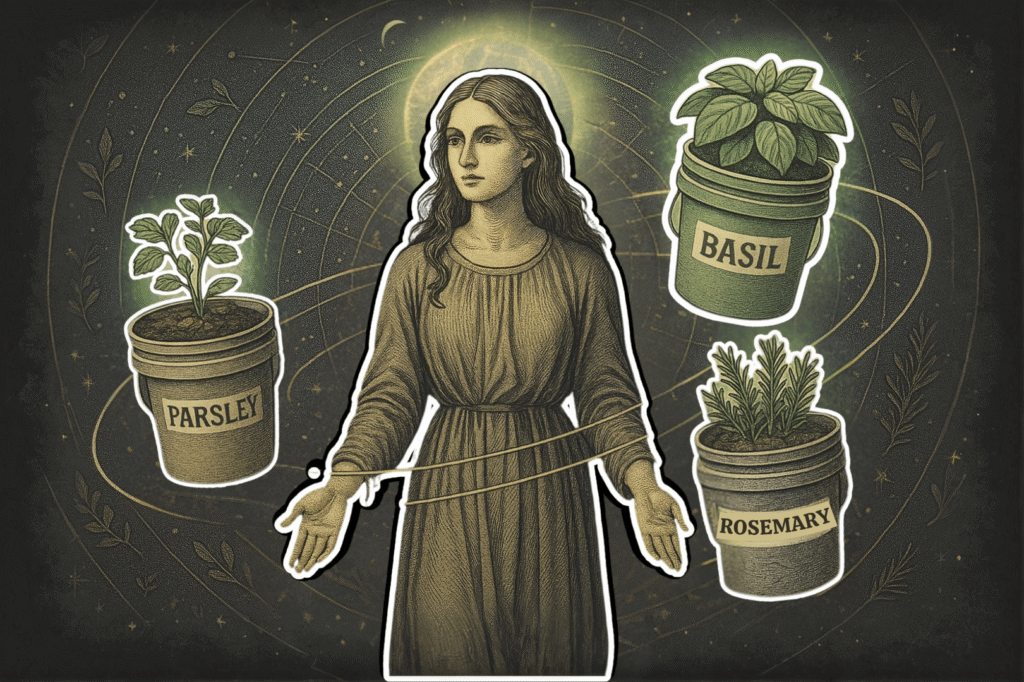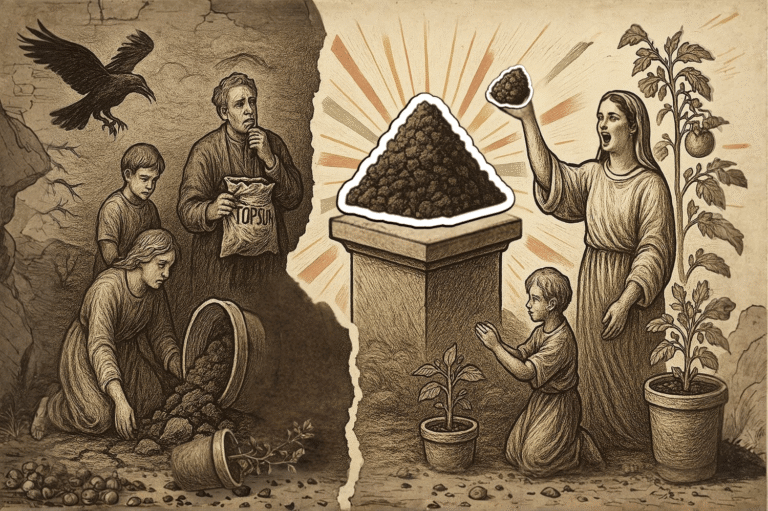Best Herbs to Grow in Containers: 3-Bucket System for Year-Round Harvests — No Garden, No Problem
You’ve killed basil before. Probably more than once. Who hasn’t? Bought it with good intentions — then watched it shrivel in the sun while you were juggling seventeen other things. I bet you still aren’t sure if you were over or under watering it, or if you gave it too much sun, or was it not enough? It seems to die either way.
Murdering herbs is not a character flaw, it’s a setup flaw. Basil is one of the best herbs to grow in containers, but herbs actually do better in buckets — if you grow them using the system below.
The Gardening App that Thinks Ahead,
so you’re never behind
Never forget another gardening task or get blindsided by bad weather and pests again. Growing made Easy
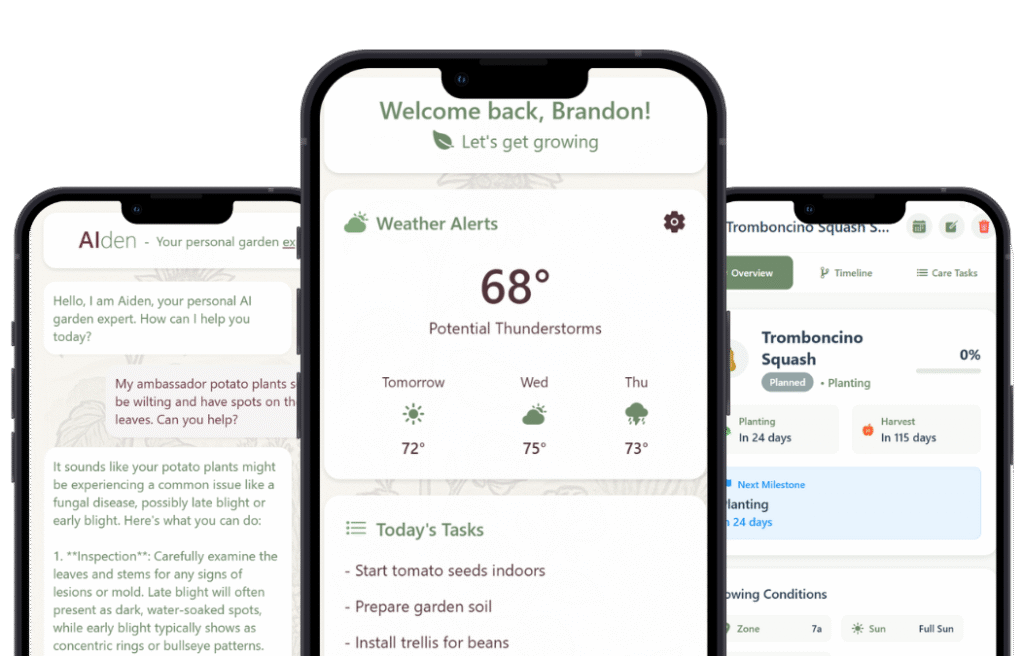
Key Points
- Use one 5-gallon bucket per herb — start with basil, flat-leaf parsley, and either rosemary or thyme.
- Plant in quality potting mix only — no garden soil, no gravel, and make sure buckets have drainage holes.
- Place buckets where you walk daily — near the kitchen, back door, or patio — so watering and harvesting become automatic.
- Harvest the right way — cut above leaf pairs and never take more than 1/3 at a time to keep plants producing.
- For non-stop herbs: succession plant cilantro, rotate basil through three growth stages, and protect perennials in winter.
Which Herbs Actually Thrive in 5-Gallon Buckets
Not all herbs are created equal when it comes to container gardening. Some spread out like your kids’ toys across the living room floor, while others stay perfectly contained and productive. The secret is choosing herbs that match both your cooking style and your available time.
Best Herbs to Grow in Containers for High-Yield
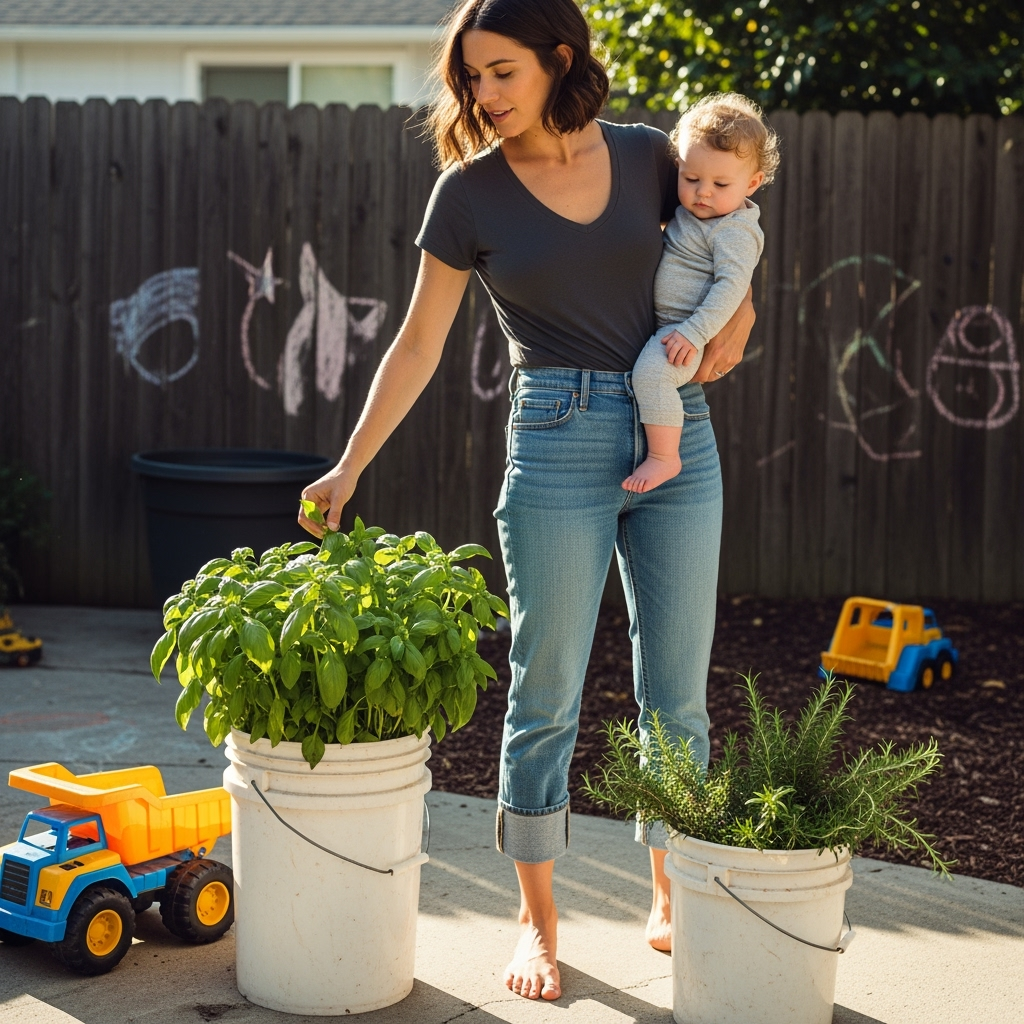
Basil stands as the undisputed champion of bucket herbs. One healthy basil plant in a 5-gallon bucket produces enough leaves for pesto every week all summer long for most small households.
Plant three varieties — Genovese for classic Italian dishes, Thai basil for stir-fries, and purple ruffles because your kids will actually eat purple food — and you’ve covered most of your cooking needs.
Parsley comes in second, and here’s why it matters: flat-leaf parsley in a bucket by your back door means you’re adding nutrition to every meal without thinking about it. Grab a handful for scrambled eggs, toss some in your soup, sprinkle over roasted vegetables. Unlike that sad bunch from the store, bucket-grown parsley stays fresh and keeps producing new growth for months.
Cilantro frustrates most gardeners because it goes to seed quickly in hot weather. But in a bucket, you control its environment. Move it to afternoon shade during summer, and suddenly you’re that mom who always has fresh cilantro for taco Tuesday.
Plant new seeds every three weeks in the same bucket, and you’ll have continuous harvest.
Low-Maintenance Herbs That Thrive in Containers
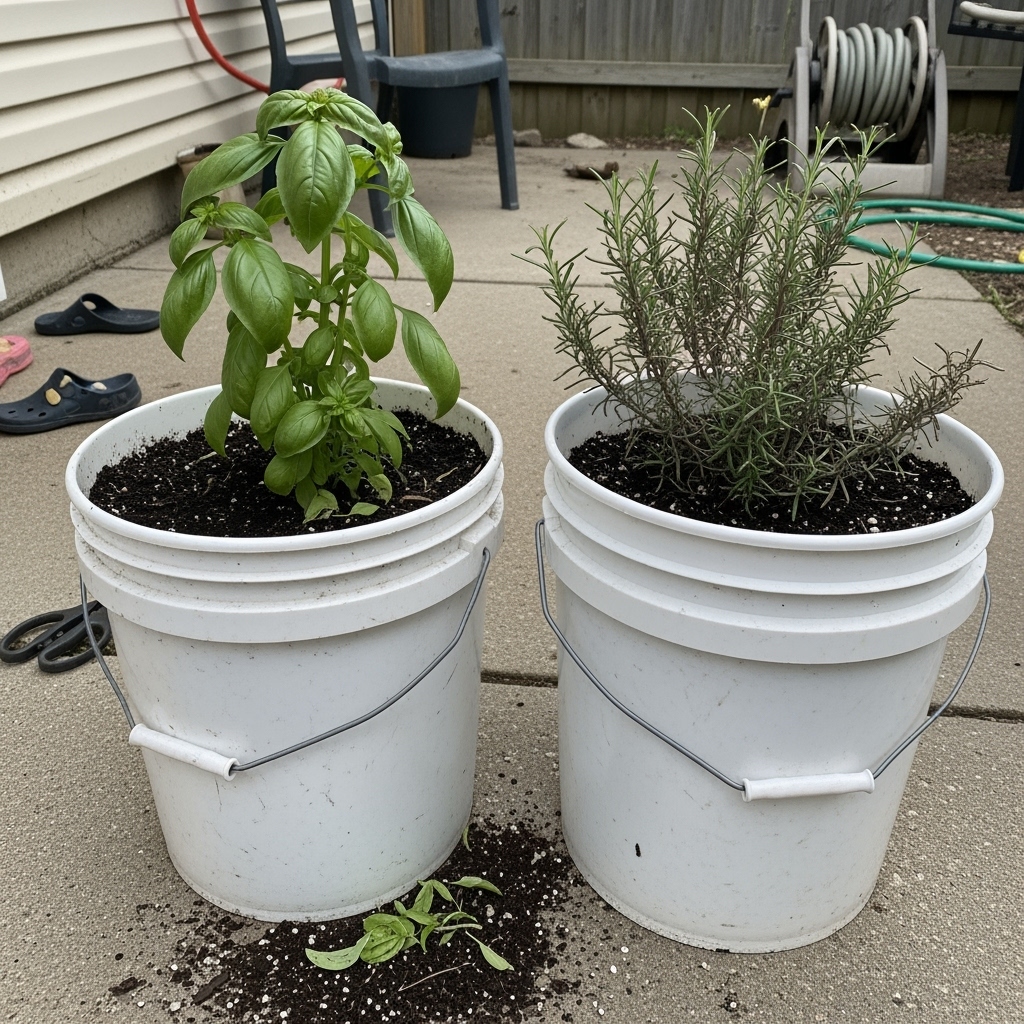
Rosemary transforms in a 5-gallon bucket from a struggling garden plant to a thriving mini-shrub. This herb forgives forgotten watering better than your husband forgives you leaving his work shirts wrinkled in the dryer.
One established rosemary plant provides enough sprigs for Sunday roasts, focaccia bread, and those fancy roasted potatoes that make everyone think you’re a gourmet cook.
Thyme offers similar low-maintenance flexibility. Both English and lemon thyme thrive in buckets, requiring water only when the soil feels dry several inches down. The plant naturally cascades over the bucket edges, creating a pretty little display that also happens to season your soups and roasted chicken perfectly.
Sage rounds out the Mediterranean trio, growing into a beautiful silvery-green bush that anchors your herb collection. One plant gives you more than enough for stuffing, brown butter sauce, and other classic recipes where a little sage goes a long way.
Where to Place Herb Buckets for Better Growth and Easy Access
Here’s where behavioral science meets herb gardening: place your herb buckets where you naturally walk every day. Put basil and parsley by the door you use to call kids in for dinner. Position rosemary near where you load the car for school pickup. When herbs live in your daily path, checking and harvesting becomes automatic, not another task on your endless list.
Your kitchen window might seem ideal, but think about your actual movements. That spot by the garage where you pause to catch your breath after unloading groceries? Perfect for cilantro. The patio table where you drink morning coffee while kids eat breakfast? Ideal for mint.
Just find one or two places to put all your herbs, don’t scatter them around. Setup buckets where they’ll actually work for your life.
How to Grow Herbs Year-Round in Buckets or Containers
Forget the myth that herbs die in winter. With strategic planning and your 5-gallon buckets’ portability, you can have fresh herbs year-round without turning into a full-time gardener. The key is working with seasonal transitions, and knowing what to do ahead of time.
How to Transition Herbs from Summer to Fall in Buckets
Most herbs actually prefer fall’s cooler temperatures to summer’s blazing heat. Your basil might sulk in August’s humidity, but come September, it explodes with new growth. Take advantage of this natural cycle by starting new plants in late July. When your summer herbs look tired, you’ve got fresh replacements ready.
Here’s your game plan: In mid-July, plant basil and cilantro seeds directly in new buckets. By the time school starts, these young plants are hitting their stride just as your original plants decline.
This overlap system means you never have that awkward gap where you’re buying herbs at the store again.
Mediterranean herbs like rosemary, thyme, and sage actually improve with age. These perennials in buckets can live for years — in mild climates or with good protection. In regions with hard freezes, bringing buckets into a garage, greenhouse, or using cold frames may be necessary for long-term survival.
Winter Protection Tips for Container Herbs
Your 5-gallon buckets become portable greenhouses with simple additions. Wrap buckets with old towels or bubble wrap during cold snaps. Group them together against a south-facing wall where they’ll absorb heat during the day. On nights expecting hard frost, throw an old sheet or frost cloth over the whole group.
For truly cold climates, here’s your secret weapon: the garage shuffle. Mediterranean herbs can handle temperatures down to about 20°F if the cold comes gradually. When arctic blasts threaten, simply roll your buckets into the garage for a few days. They don’t need light for short periods, just protection from extreme cold.
Tender herbs like basil won’t survive winter outdoors. For these, just take cuttings in early fall, root them in water on your windowsill, and transplant them into small pots indoors. You’ll have fresh basil through winter without needing to start from seed again.
How to Keep Herbs Producing in Containers (Succession Planting Tips)
Herbs don’t last forever — especially ones like cilantro and basil. If you want a steady supply instead of feast-or-famine, you need to plant in waves. It’s called succession planting, and it works just as well in buckets as it does on a farm.
Use one bucket for multiple plantings of the same herb. Divide it into quarters mentally. Plant one quarter with cilantro seeds. Two weeks later, plant the next quarter. By the time you’re planting the fourth quarter, the first is ready to harvest. This rotation continues all season in a single bucket.
For basil lovers, maintain three buckets in different growth stages: one mature plant you’re actively harvesting, one teenage plant growing strong, and one baby plant just getting started. Rotate their positions based on growth needs — babies get the prime sunny spot, mature plants can handle partial shade.
Related Guides
How to Harvest Herbs in Containers for Maximum Growth
Most herb failures happen not from neglect but from incorrect harvesting. Your herbs want to be cut — it’s literally what they’re designed for, to be eaten. But cutting them wrong leads to woody stems, reduced production, and just ugly plants.
The Pinching Principle for Bushy Growth
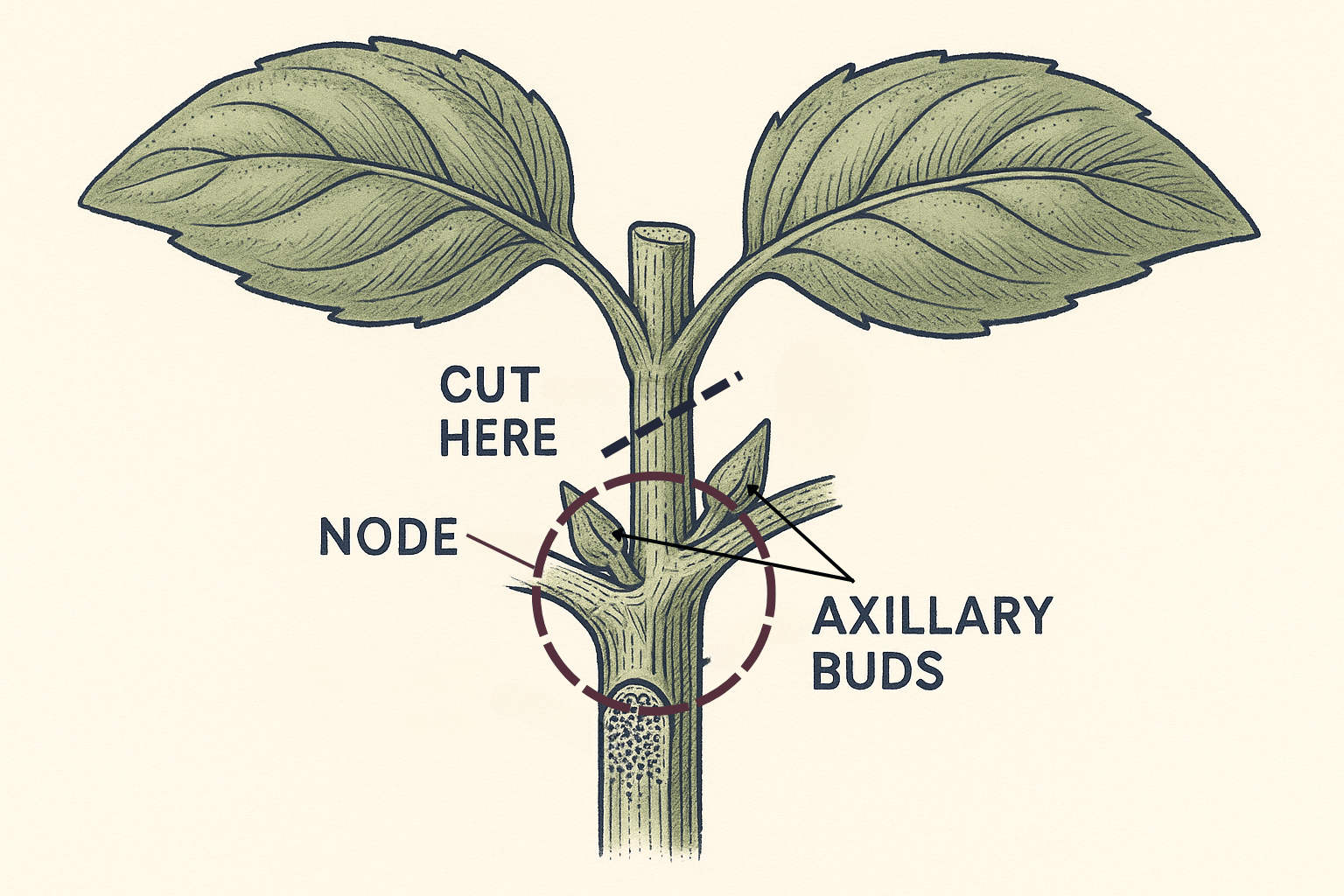
Basil teaches the foundational harvest principle: always cut above a leaf pair. See where two leaves emerge from the stem? Cut right above that point. Within days, two new stems grow from that spot. You’ve just doubled your future harvest with one strategic cut.
This multiplication miracle works for most leafy herbs. Pinch oregano, mint, and sage the same way. The plant responds by branching out instead of growing tall and woody. Your single-stem grocery store basil transforms into a bushy production machine through proper pinching.
Start harvesting when plants reach 6 inches tall. Don’t wait for some perfect moment — herbs grow stronger with regular harvesting. That tentative snip you’re avoiding? Your plant craves it. Take up to one-third of the plant each time, focusing on the top growth that’s reaching for the sky.
If you’re not ready to eat it fresh or cook with it, dry out the leaves and save them for seasoning.
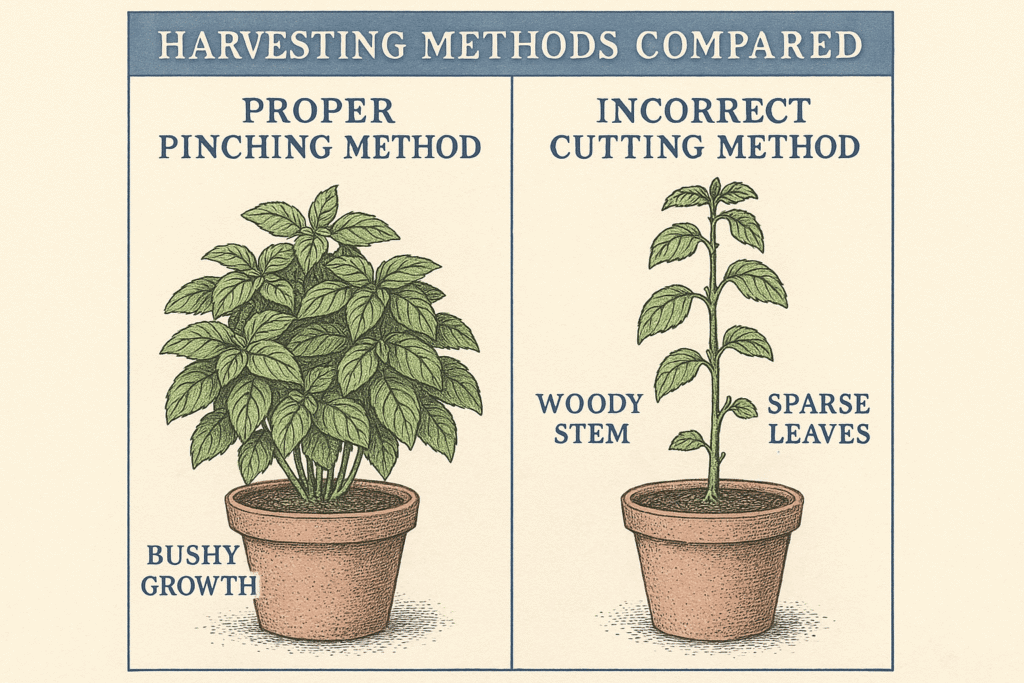
Timing Your Harvests for Maximum Flavor
Morning harvesting isn’t just garden folklore — it’s flavor science. Herbs produce essential oils overnight, concentrating them in leaves before the day’s heat. Harvest after morning dew dries but before the sun gets intense. Your 10 AM coffee break? Perfect herb-cutting time.
But here’s the busy mom reality: harvest when you can. Fresh herbs cut at 5 PM still beat store-bought herbs cut who-knows-when. The “perfect” timing matters less than the “consistent” timing. Build herb harvesting into existing routines rather than creating new ones.
For woody herbs like rosemary and thyme, timing matters less than technique. Cut entire stems rather than plucking individual leaves. Use sharp scissors to make clean cuts that heal quickly. These tougher herbs handle afternoon harvesting just fine.
Extending Harvest Through Strategic Cutting
Your herbs have their own goal: making seeds to ensure survival.
Your goal: preventing seed production to ensure continuous leaves. This natural tension becomes your advantage when you understand flowering patterns.
Basil sends up flower spikes when stressed or mature. Pinch these immediately — not tomorrow, not later, but the moment you see them. Each flower spike you remove redirects energy back to leaf production. Miss a few flowers, and your basil thinks its job is done, shutting down leaf production.
Cilantro plays by different rules, bolting (going to seed) quickly in heat regardless of your pinching. Work with this tendency, not against it. Let one plant flower and set seed — those seeds become coriander for your spice cabinet. Meanwhile, keep succession planting for fresh leaves.
Parsley, being biennial, won’t flower its first year. This gives you an entire season of worry-free harvesting. Cut outer stems at soil level, leaving the center crown to produce new growth. One parsley plant harvested this way feeds a family all season.
What to Do This Week
Time to stop scrolling herb garden inspiration and start growing actual herbs. This week, you’re creating the foundation for year-round fresh seasonings. Here’s your action plan:
Day 1-2: Set-up three 5-gallon buckets with drainage holes. Hit up a bakery for free food-grade buckets or grab them from the hardware store. While you’re there, buy your seeds/starts and quality potting mix — not garden soil, not topsoil, but actual potting mix designed for containers (and a bag of compost if you can).
Day 3-4: Plant your starter trio — basil, parsley, and either rosemary or thyme. Buy seedlings this first time for instant gratification. Plant them in late afternoon when it’s cooler, water thoroughly, and place where you’ll see them daily.
Day 5-7: Establish your checking routine. Every time you walk past your herbs, run your finger an inch into the soil. Dry? Water slowly until it runs out drainage holes. Still moist? Move along. This finger-check habit prevents both overwatering and neglect.
Bonus challenge for overachievers: Start cilantro seeds in a fourth bucket. Direct seed half the bucket now, mark your calendar to seed the other half in two weeks. You’ve just created a succession planting system that will keep you in fresh cilantro all season.
Bottom Line
No more sad herb clamshells. No more dead grocery store plants.
Three buckets. A few minutes a day.
That’s your year-round fresh seasoning system — powered by 5-gallon buckets and perfect for anyone growing a herb garden in pots or containers.
FAQ
External Resources
- Herb Container Gardens – Utah State University Extension (PDF)
Comprehensive guidance on growing a herb garden in pots, including container size, potting soil recommendations, watering techniques, and harvesting practices for culinary herbs. - Container gardening with vegetables and herbs – Michigan State University & Michigan Dept. of Health (PDF)
Detailed recommendations on the best herbs to grow in containers, ideal soil mixes, proper drainage setup, and container size — including herb-specific planting tips for parsley, sage, and rosemary. - Growing Herbs in Containers – University of New Hampshire Extension
Evidence-based advice on growing a herb garden in pots, covering both annual and perennial herbs like basil, cilantro, and thyme, along with guidance on watering, soil selection, and optimal potting containers. - Overwintering Plants in Containers – Penn State Extension
Covers how to protect the best herbs to grow in containers through winter by insulating buckets and relocating them during extreme cold — ideal for gardeners growing herbs in 5-gallon containers year-round. - Winter Protection of Containerized Ornamental Plants – Arboriculture & Urban Forestry Journal (.gov/scholarly)
Scientific overview of cold-weather risks for root systems in container-grown herbs, including strategies to overwinter the best herbs to grow in containers like rosemary and sage. - The Myth of Drainage Material in Container Plantings – Washington State University Extension (PDF)
Explains why gravel should be avoided in herb containers and reinforces best practices for drainage when growing a herb garden in pots — using only quality potting mix and drilled bucket holes. - Top 5 Succession-Planted Crops for Extending the Harvest – High Mowing Seeds (industry authority)
Industry-backed techniques for succession planting cilantro and basil — two of the best herbs to grow in containers — to ensure consistent harvests when growing a herb garden in pots or buckets.

